This is the website of Abulsme Noibatno Itramne (also known as Sam Minter).
Posts here are rare these days. For current stuff, follow me on Mastodon
|

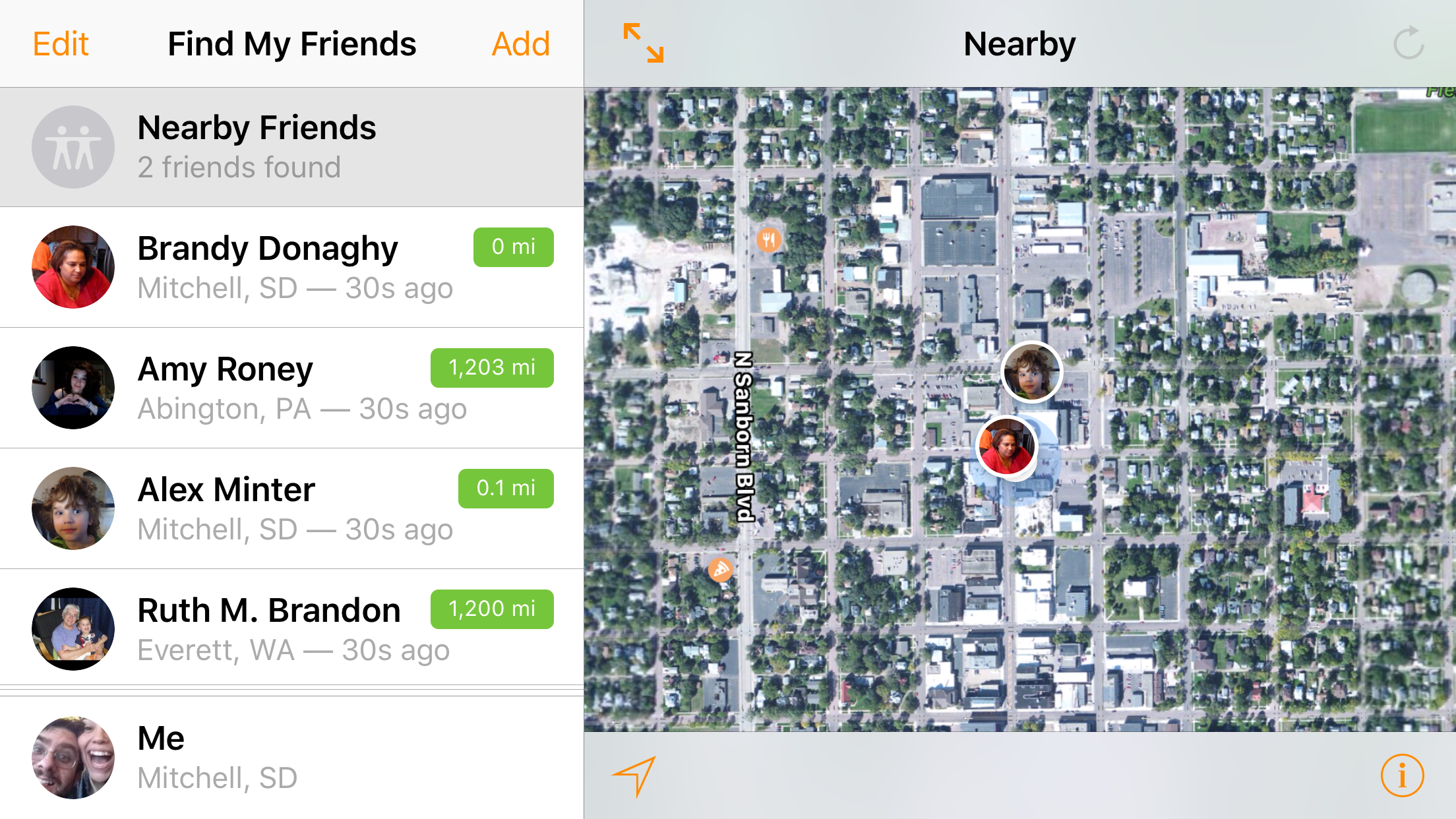
On Saturday, Brandy whizzed right by the Porter Sculpture Park and wouldn’t turn around to go check it out. But a little bit later we did stop at the point the GPS said we were exactly 1201 miles from Amy back in Pennsylvania, and exactly 1201 miles from my mother in Washington State. That’s one way of defining the half-way point, although not the only one of course, and maybe not the best one. But it is the one we used today. We stopped and took pictures. Remarkably, it wasn’t just a field by the side of the road. But it was only a parking lot. VERY near by though, was the Corn Palace! So was the “fun place of the day”. 1203 miles from Amy, and exactly 1200 miles from my mom.
Alex Verdict: Most of it wasn’t even corn. And it wasn’t a palace.
Brandy Verdict: Corny.
Sam Verdict: Should have been a couple miles further east.
A number of hours later, we of made the required pilgrimage to Wall Drug, but we did not stay long.
Trump clinched the nomination a week and a half ago but there were a few more contests left. CA/NJ/SD/MT/NM have now weighed in with their 303 delegates. Trump got all 303. As an unopposed candidate at this point, this is not unexpected.
And while the Democrats still have DC left, this is the end of the primary process on the Republican side. There are still 18 uncommitted delegates whose preferences are unknown, but their decisions at this point won’t change much.
Lets look quickly at the updated graphs:
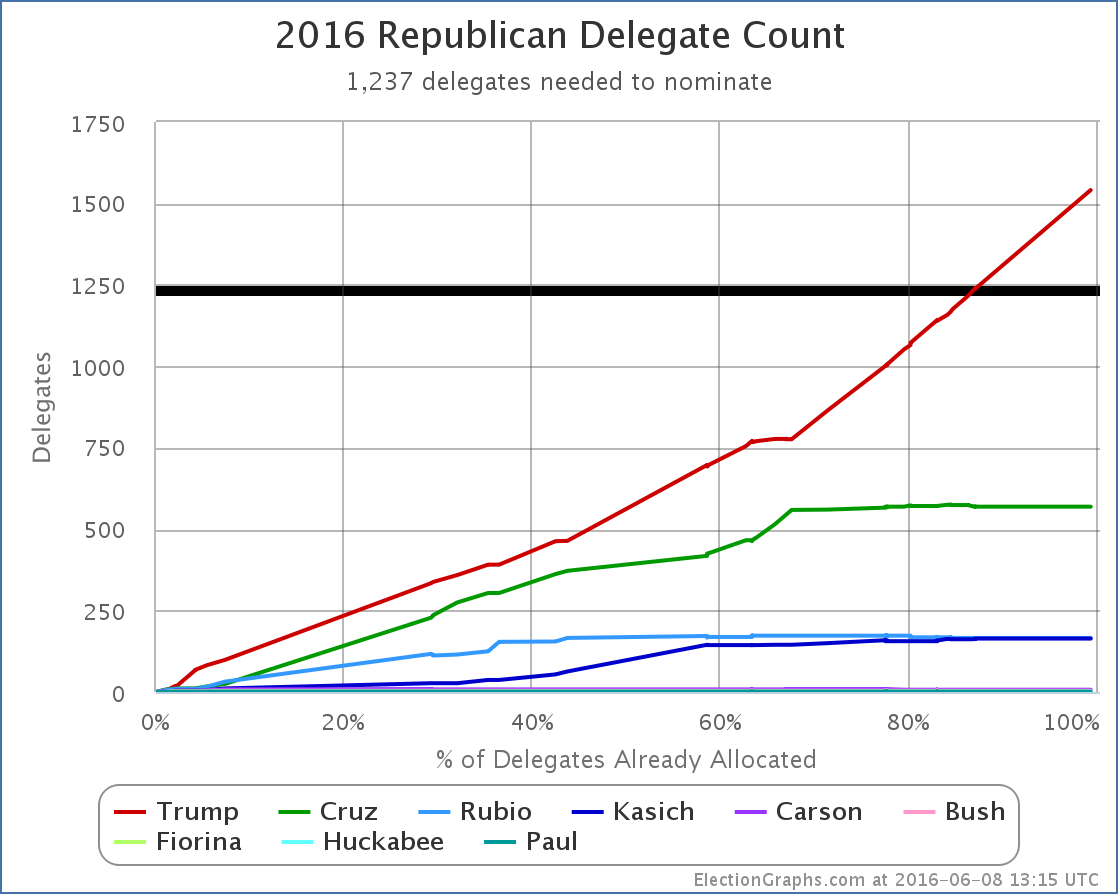
With this update Trump moves from just barely over the “magic number” to well over it with plenty of room to spare. The delegate count is now: Trump 1541, Cruz 569, Rubio 166, Kasich 164, Carson 7, Bush 4, Fiorina 1, Huckabee 1, Paul 1.
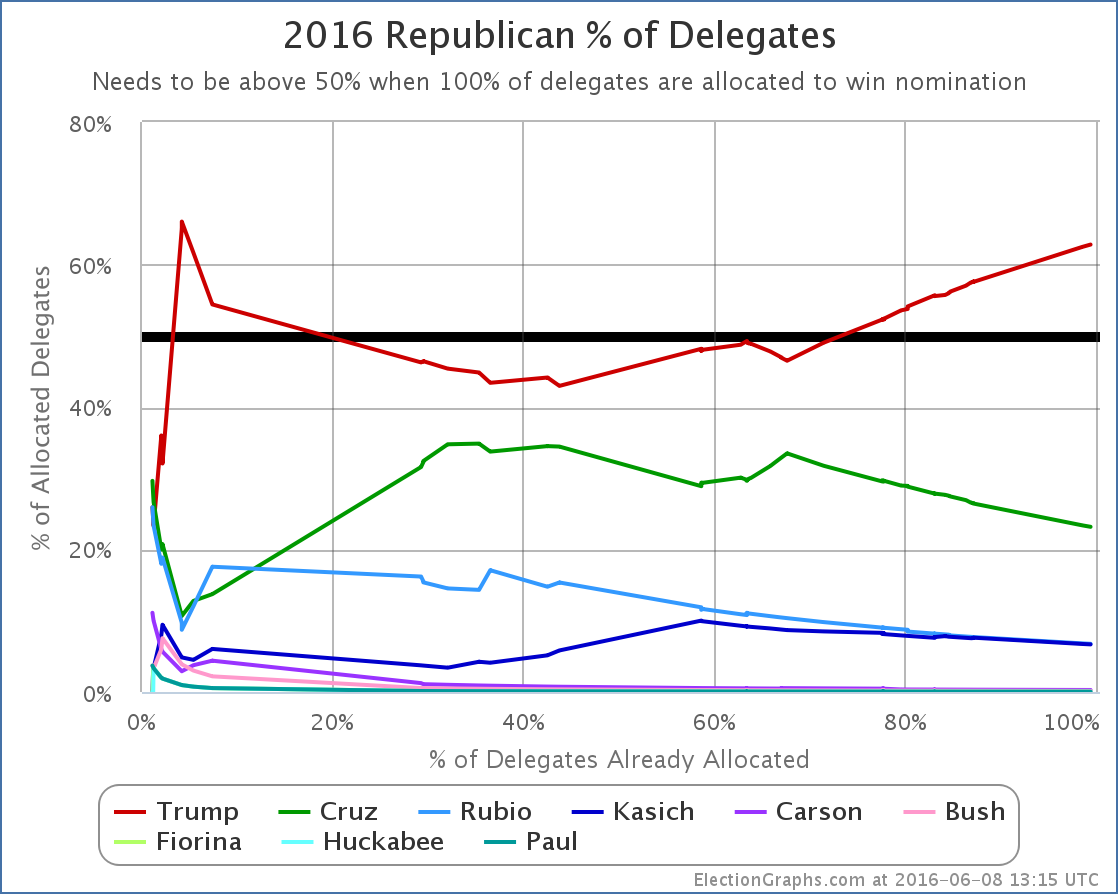
Trump now has 62.80% of the delegates allocated so far.
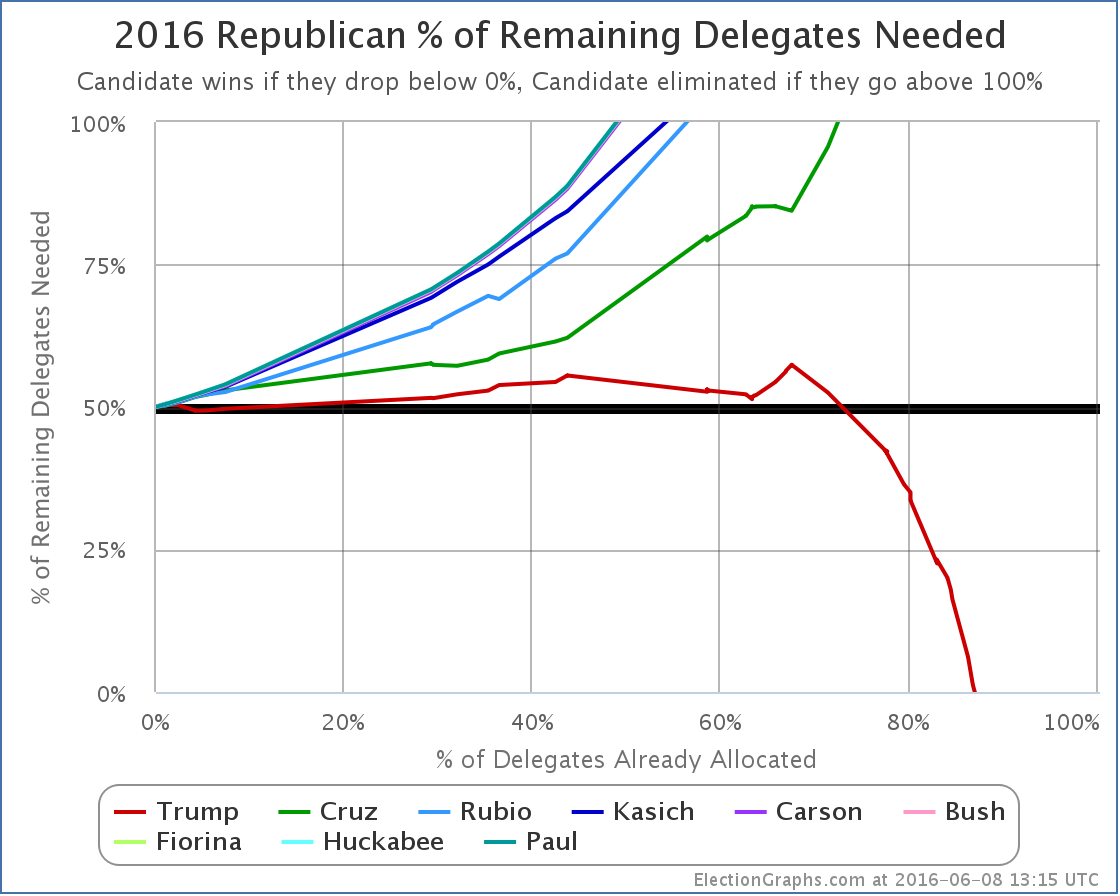
And just for reference, the “% needed to win” in final form.
There isn’t much more to say since this race is over minus any unexpected craziness. If there are any additional developments of note, we’ll update accordingly, but none is expected at the moment.
Time to concentrate on the general election.
Update 2016-06-30 06:00 UTC – Update from Vermont. Net change Kasich -1, Paul +1. (A Kasich delegate who considered themselves free after Kasich dropped out pledged his support to Paul.)
Update 2016-07-20 07:19 UTC: Final Election Graphs estimate was Trump 1541, Cruz 569, Rubio 166, Kasich 163, Carson 7, Bush 4, Paul 2, Fiorina 1, Huckabee 1, TBD 18. We now have the official roll call from the Republican National Convention: Trump 1725, Cruz 484, Kasich 125, Rubio 123, Carson 7, Bush 3, Paul 2, DNV 3. Differences were due to the application of rules in some states requiring all votes to go to candidates that were actually nominated (only Trump was officially nominated at the convention) and movement of additional uncommitted delegates to Trump.
Note: This post is an update based on the data on ElectionGraphs.com. Election Graphs tracks both a poll based estimate of the Electoral College and a numbers based look at the Delegate Races. All of the charts and graphs seen in this post are from that site. Additional graphs, charts and raw data can be found there. Follow @ElectionGraphs on Twitter or like Election Graphs on Facebook to see announcements of updates or to join the conversation. For those interested in individual general election poll updates, follow @ElecCollPolls on Twitter for all the polls as they are added. If you find the information in these posts interesting or useful, please consider visiting the tip jar.
By the Election Graphs count, Clinton now has 2745 delegates, which puts her well over the 2383 require to clinch the nomination.
As they did with the Republicans, AP went out and called many still publicly uncommitted superdelegates and was able to get the winning candidate to the magic number in their count a little earlier than those of us only using public commitments. In this case AP made their announcement Monday. The count here went over the magic number within minutes of the polls closing in New Jersey Tuesday night.
As of the writing of this post, all but 4 straggling delegates from New Jersey out of the 694 delegates up for grabs last night seem to be reasonably determined, so lets run down then numbers.
After Puerto Rico, Clinton only needed 5.05% of the remaining delegates to win. Sanders needed 95.19% of the remaining delegates. Clinton needed 43 delegates, Sanders needed 811.
In CA/NJ/NM/MT/SD/ND Clinton got 391 delegates while Sanders got 299. (As mentioned, there are still 4 TBD from NJ as of this writing.)
In the days between Puerto Rico and the June 7th results coming in, superdelegate changes yielded a net change of: Clinton +14, Sanders +1, O’Malley -1. Yes, that lone O’Malley superdelegate finally flipped… to Clinton.
Total change since Puerto Rico: Clinton +405, Sanders +300, O’Malley -1
That is Clinton 57.53%, Sanders 42.61%. (Adds to more than 100% because Clinton took the one delegate from O’Malley.)
So Clinton met her target, Sanders did not.
405 delegates is significantly more than the 43 delegates Clinton needed to go over the top.
She clinches. She is the presumptive nominee.
Lets check out the updated graphs:
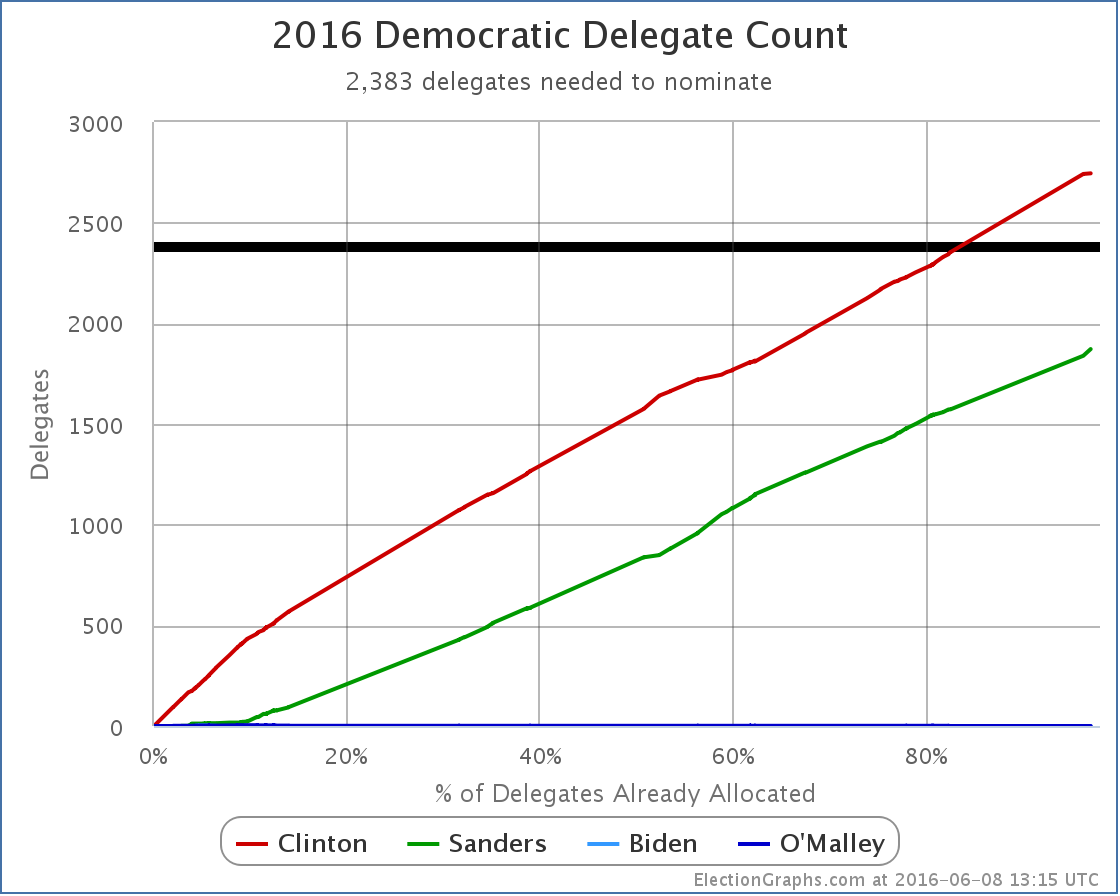
New delegate totals: Clinton 2745, Sanders 1872. Clinton blows past 2383 and is now well beyond where she needed to get.
There are 148 delegates left. Washington DC has 20 up for grabs next week. There are those 4 from New Jersey too. The other 124 are superdelegates who have not yet stated a preference. Clinton needs none of these delegates. Sanders could get every single one of these delegates, and would still lose decisively.
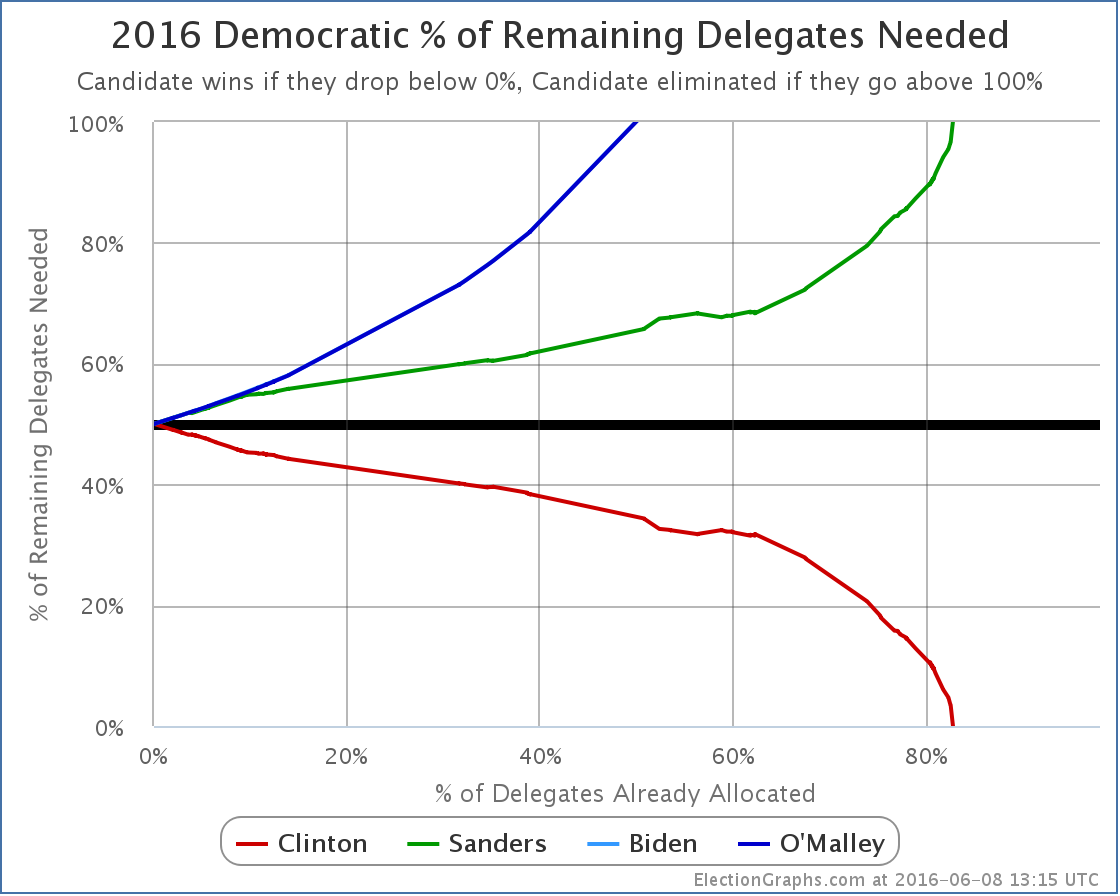
The “% of delegates needed to win” chart is complete. Clinton dropped below 0%, Sanders went above 100%.
One more graph:
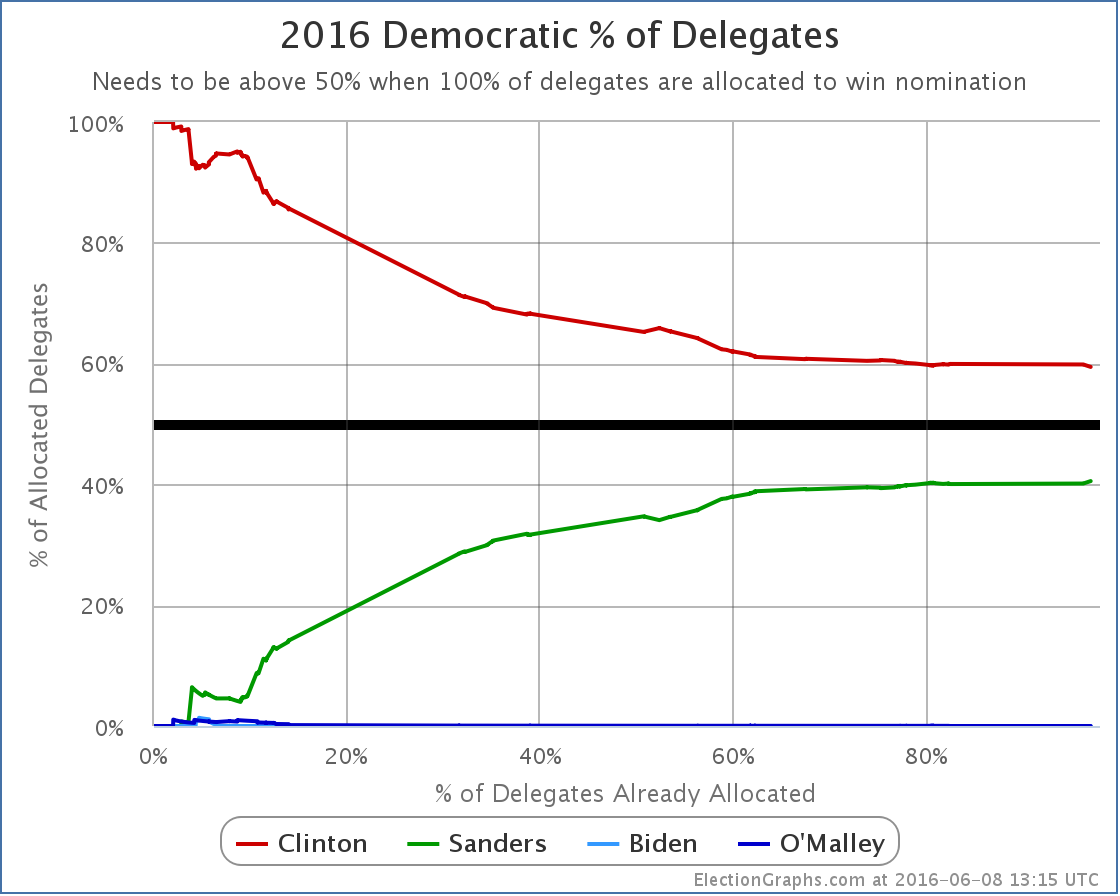
Since she started at 100% of the delegates by getting superdelegates before the first primaries or caucuses even happened, Clinton’s “% of delegates” number of course trended downward through most of the cycle. But for quite some time now the delegate race has stuck pretty close to being a 60% to 40% split in Clinton’s favor. As of now, it sits at Clinton 59.45%, Sanders 40.55%.
OK, now to step back a little…
Clinton dominated this race from the beginning. There were only a handful of moments where Sanders even managed to close the gap a little bit. Sanders was never even close. It was clear since the beginning of March… at the latest… that is being generous… it was fairly clear even before that… that Sanders catching up would take a miracle. The one thing that has been amazing throughout the primary process is the ability of many Sanders supporters to be in complete denial about this in the face of overwhelming evidence. It is one thing to be enthusiastic about your candidate and even to hope for that miracle, but it is another thing to not even recognize that you are losing and that it would indeed take that miracle to win.
And yes, some of those Sanders folks are still in denial even now. Because superdelegates. So a quick look. Right now we have Clinton 2745, Sanders 1872. There are 124 remaining superdelegates. Lets give them all to Sanders. For fun give Sanders all 20 DC delegates and the 4 from New Jersey too. Now we have Clinton 2745, Sanders 2020. All delegates are now allocated. Sanders is still short. To get to 2382 he would need at least 182 delegates who have committed to Clinton to change their minds and vote for Sanders instead. Clinton has 532 superdelegates by the latest count. So that means 34.2% of the superdelegates currently committed to Clinton would have to flip.
They would have to do that flip in the face of Clinton having won the popular vote (even if you include estimated popular vote for caucus states), Clinton having won the pledged delegate count, and Clinton having won the most states. Not to mention significant numbers of the superdelegates not simply being lukewarm Clinton supporters, but being people who she has actively cultivated for many years, a good number of which have actually been active in her campaign.
Is it mathematically possible? Yes. Of course it is. Is it going to happen absent something catastrophic happening to Clinton? No.
Some Sanders folks are still holding out the “What if Clinton is indicted?” scenario. My guess is most superdelegates would consider it an unfair and unjust indictment and stick by their candidate. It probably wouldn’t be enough. Perhaps I suppose. It is a stretch though. More realistically it would take a debilitating health issue or some brand new scandal so serious it dwarfs everything that has come up so far. Can you imagine these sorts of things? Of course. But they are all unforeseen unpredictable types of event, not things you decide to continue a campaign based on. After all, there are ways Martin O’Malley can still win the nomination too!
You can conjure similar scenarios on the other side too of course, but absent that kind of craziness, we now have our nominees in both parties.
So we have Clinton vs Trump. Time to start focusing on the general election analysis!
153.4 days until polls start to close on election day!
Update 2016-06-12 17:16 UTC – Superdelegate update. Net Change: Clinton +11
Update 2016-06-12 17:43 UTC – Missed one change in the superdelegate update above. Additional Change: Clinton -1. (So Clinton +10 for this day’s scan.)
Update 2016-06-12 18:02 UTC – Updates from California, New Jersey, and South Dakota (including the remaining 4 TBD delegates from New Jersey). Net change: Sanders +4.
Update 2016-06-15 01:40 UTC – Superdelegate update. Net Change: Clinton -3, Sanders +1.
Note: This post is an update based on the data on ElectionGraphs.com. Election Graphs tracks both a poll based estimate of the Electoral College and a numbers based look at the Delegate Races. All of the charts and graphs seen in this post are from that site. Additional graphs, charts and raw data can be found there. Follow @ElectionGraphs on Twitter or like Election Graphs on Facebook to see announcements of updates or to join the conversation. For those interested in individual general election poll updates, follow @ElecCollPolls on Twitter for all the polls as they are added. If you find the information in these posts interesting or useful, please consider visiting the tip jar.
Edit 15:19 UTC to mention the 4 delegates from New Jersey in the list of remaining delegates and the calculations for superdelegates flipping.
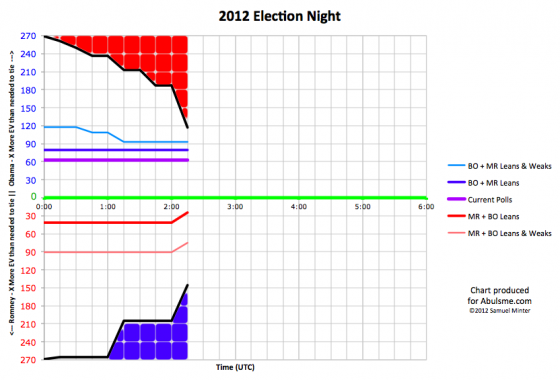
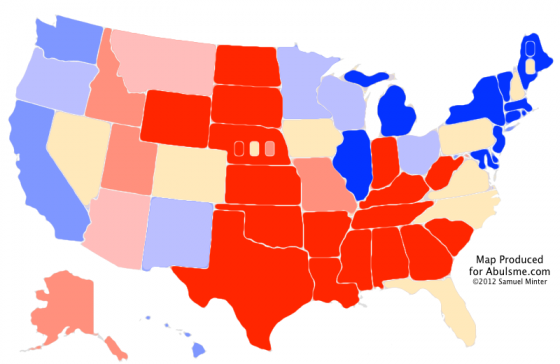
|
Romney |
Obama |
| Romney Best Case |
294 |
244 |
| Current Status |
206 |
332 |
| Obama Best Case |
190 |
348 |
No states were called between 01:45 UTC and 02:00 UTC, but a ton were called between 02:00 UTC and 02:15 UTC:
- Romney: KS, LA, NE-All, NE-1, ND, SD, TX, WY, MS
- Obama: MI, NY, NJ
All of these were no brainer expected states, except for Michigan. Michigan is the first state of the night to be called where the margin was less than 5% in the polls, so winning this state made a difference between the “best cases” that I present. Obama was ahead here by 4.5%, so a win here was predicted, but it was a close state and one that Romney really needed.
As of the final update I made on election day, Michigan was the tipping point state. That means Romney had to win all the states he was doing better in than Michigan PLUS Michigan in order to win. He just lost Michigan, which means he now needs a state he was further behind in that Michigan in order to win.
This is very bad news to Romney. His path to victory is now not quite impossible, but very close. Let’s look:
With all the states he has already won, plus the uncalled states where Romney was ahead by more than 5%, he had 190 electoral votes. Then the areas he was ahead in:
- Nebraska 2nd (1): 3.8% Romney lead
- North Carolina (15): 1.4% Romney lead
That gets Romney to 206. He needs 63 more electoral votes. Looking at the remaining states that haven’t yet been called:
- Iowa (6): 2.0% Obama lead
- Florida (29): 2.3% Obama lead
- Colorado (9): 2.4% Obama lead
- New Hampshire (4): 2.8% Obama lead
- Maine 2nd (1): 2.8% Obama lead
- Virginia (13): 3.6% Obama lead
- Pennsylvania (20): 4.8% Obama lead
- Nevada (6): 4.8% Obama lead
If Romney wins all of those through Pennsylvania, it gets him to 288 electoral votes, which wins him the Presidency. If he doesn’t win Pennsylvania to win, he needs every other one of those states, including Nevada, which would get him to 274. If he does win Pennsylvania, then he could afford to lose Virginia, New Hampshire and Maine’s 2nd (and Nevada).
But that is a very tall order! And there will be another update coming soon…
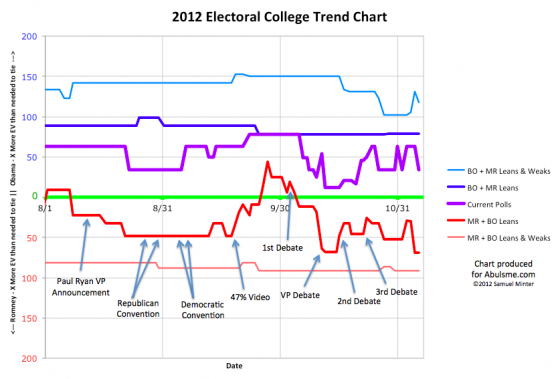
Today was by far the biggest update I’ve ever done. New polls in 31 states plus the Maine congressional districts. Absolutely exhausting checking all my sources and entering in all the data today. After all that though, the result is three states changing status, with none of those status changes making a big difference in the race. Time for a quick look before we get to the meatier stuff:
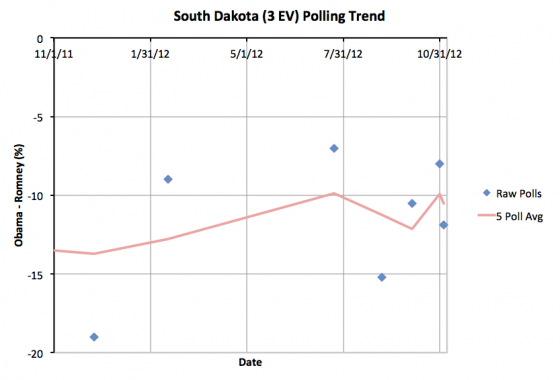
On Saturday Romney’s lead in the South Dakota five poll average dropped below 10%. With today’s update is is once again slightly more than 10%. Romney’s going to win South Dakota. (Graph shows a year since polling has been so sparse here.)
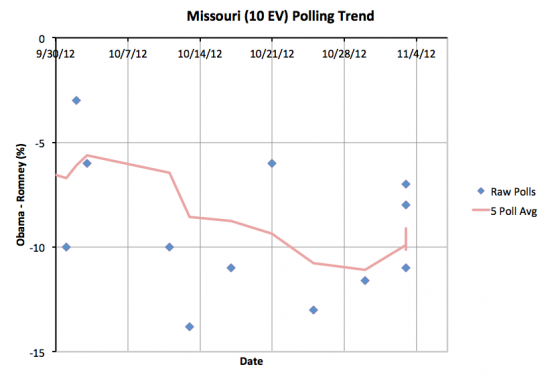
Some story in Missouri. Just yesterday Romney’s lead in the five poll average dipped below 10%. Today it is above 10% again. Romney will win Missouri.
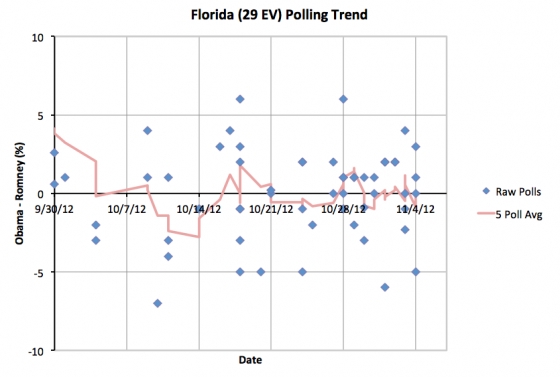
Finally Florida. While the other two don’t really matter much to the state of the race because Romney is clearly going to win both, Florida isn’t all that significant right now because the fact that Florida has once again bounced across the line, and now has Romney narrowly ahead, does not actually give any additional insight into the state of the race in Florida. Florida has been bouncing back and forth close to the line. Small fluctuations up and down are just sampling noise. The best we can say about Florida is that it is tied, and there is no indication that the state is breaking one way or another. As I’ve said several times before, we’ll know which way Florida goes once all the votes are counted. We may not even know on election night depending how it goes.
So, the current state of the race with just about a day to go before the polls start closing:
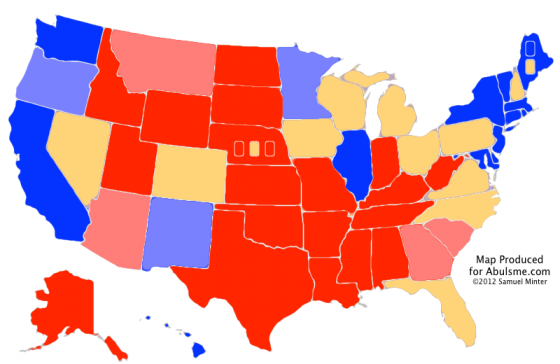
|
Romney |
Obama |
| Romney Best Case |
338 |
200 |
| Current Status |
235 |
303 |
| Obama Best Case |
190 |
348 |
So goodbye to 332-206 for the moment, and perhaps for good. There isn’t that much time left after all.
Fundamentally, we have no significant change to the race today in terms of the three main lines in my summary. Obama is still heavily favored, but Romney can still win if he manages to defy expectation and win in a bunch of the close states.
So, here we go again, looking at those close states.
With just the states he is ahead in by more than 5%, Romney starts at 190 electoral votes. Then if we go in order…
- Nebraska 2nd (1): Romney ahead by 3.8%
- North Carolina (15): Romney ahead by 1.4%
- Florida (29): Romney ahead by 0.4%
That is all the states (and CDs) Romney is actually ahead in based on my five poll average. That gets him to 235 electoral votes. 34 electoral votes short. If you continue to bring the states in order of Romney’s support level…
- Colorado (9): Obama ahead by 1.2%
- Virginia (13): Obama ahead by 1.6%
- Iowa (6): Obama ahead by 2.0%
- New Hampshire (4): Obama ahead by 2.8%
- Maine 2nd (1): Obama ahead by 2.8%
- Ohio (18): Obama ahead by 3.1%
Ohio is once again the tipping state. If Romney pulled all of these in, he would have 286 electoral votes and therefore win the presidency. Now, if Romney does indeed win Ohio, he could then afford to actually lose Iowa, New Hampshire and Maine’s 2nd.
This leaves Romney’s current “easiest path to victory” to be holding on to the three states he is ahead in, and then pulling ahead and winning in Colorado, Virginia and Ohio.
There are other paths involving the remaining close states, which are:
- Pennsylvania (20): Obama ahead by 4.2%
- Wisconsin (10): Obama ahead by 4.3%
- Michigan (16): Obama ahead by 4.5%
- Nevada (6): Obama ahead by 4.8%
There are certainly ways some of those states could be part of a path to 270 (or 269) for Romney, but since Obama is even further ahead in those states, that kind of movement seems even more unlikely.
So looking at the tipping point margin graph:
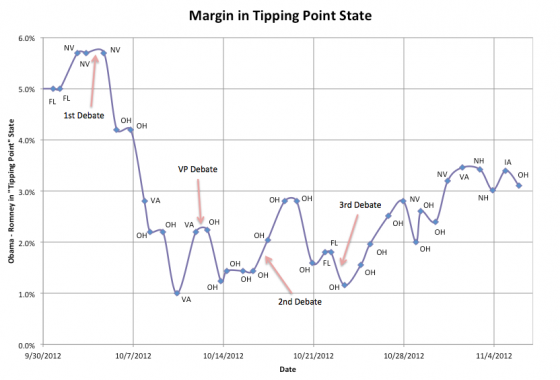
The race has been stable for the last week.
Romney is out of time. If there was going to be a last minute move toward Romney in the swing states, it needed to have been happening over the last few days. There is nothing. States appear to be jiggling around a bit due to the sheer volume of polling that is happening right now, but there is no real indication of any movement that makes any sort of difference to this race.
The best bet for the Romney team remains that all the polls are just systematically wrong, and the reality is that a lot of the states I listed above are actually at least 3% better for Romney than they look from the polling. There HAVE been presidential election years where the state polls were off by that much. So this is not impossible….
…just pretty unlikely.
Absent a miracle for the Romney folks, this looks like Obama getting reelected.
Before I close for the day, just a quick note.
The plans for abulsme.com for the next 48 hours had been one final update to these polling charts before the polls start to close less than 24 hours from now. After that I was planning to do what I did in 2008, which was updates to the website every 15 minutes or so as states get called one way or the other by the major networks. The networks usually only call the election itself when one candidate actually gets to 270 electoral votes, but really, you will probably know well in advance of that, as one can already assume how many states will go. You do not have to wait for the polls to close in California to know that Obama will win California for instance.
The plan above may still happen, but life may get in the way. I just got word within the last two hours that my mother-in-law is getting released to go home after having had major surgery a couple of weeks ago… which is great, because it means she is doing well, but my wife needs to be there when she gets discharged, and to help her during the first week or two home. So my wife may need to be flying out of here, possibly as soon as tomorrow. Is she does, depending on exact schedules, I may not be able to do “election night coverage” after all as I’ll be needing to deal with things at home. If so, I might post the occasional comment on twitter, but won’t be furiously updating graphs all night long.
I should know better about what my plans will be by the time I post my final update tomorrow. Thanks for you patience!
Note: Chart and map from the Abulsme.com 2012 Electoral College Prediction page. Both assume Obama vs Romney with no strong third party candidate and show polling as it currently exists. Things will change before election day. On the map red is Romney, blue is Obama, gold states are too close to call. Lines on the chart represent how many more electoral votes a candidate would have
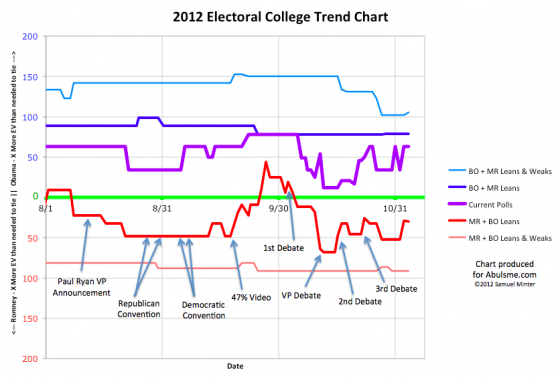
Two category changes today. Frankly, neither are significantly impactful to the overall state of the race, but let’s take a look anyway.
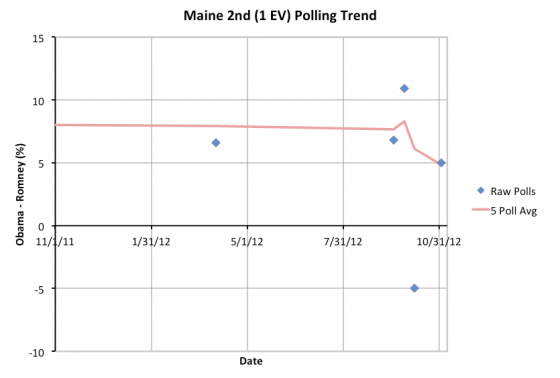
I am showing a whole year on the chart since polling has been extremely parse in Maine’s 2nd congressional district. Like Nebraska, Maine gives two electoral votes to the statewide winner, then one each for winning each congressional district. Last weekend I talked about Nebraska’s 2nd dropping into “Lean Romney” territory. This weekend we have Maine’s 2nd dropping into “Lean Obama” territory.
ME-2 has been very sparsely polled. Prior to today, I was still using the 2008 general election results to “pre-fill” the five poll average. Obama won ME-2 by 11.3% in 2008, so that helped push his numbers upward. With that rolling off the five poll average, plus an October poll showing Romney ahead by 5%, the five poll average drops to 4.9% and so I reclassify ME-2 as “Lean Obama” and I now consider Romney to have a chance there.
4.9% seems pretty substantial though, so Obama is still pretty safe here, right? Well, maybe. Bottom line is that ME-2 now joins NE-2 to produce the two “closest” electoral votes without a substantial amount of polling. Sure, the five poll average gives Obama a 4.8% lead. But if you only take polls from the last month, it is a tie. Now, there is reason to be suspicious of that poll showing Romney ahead, but it is what it is and I include it. The reality though is that like Nebraska’s 2nd, Maine’s 2nd is just an area where we’re somewhat blind.
From the few polls we DO have, it seems the best we can say is that NE-2 is close, but still more likely to go for Romney, and ME-2 is close, but still more likely to go to Obama.
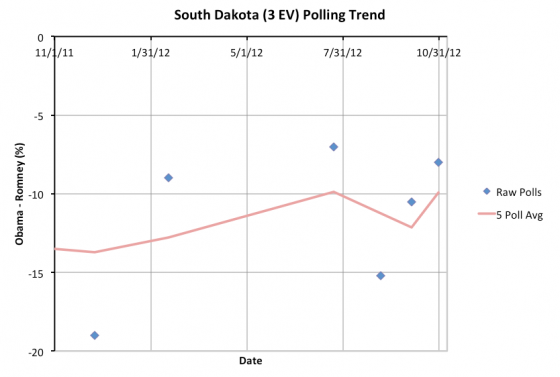
Showing a year of history here as well, since South Dakota is also sparsely polled. Unlike ME-2 and NE-2 though, which are closer than some states that are polled much more frequently than they are, South Dakota is sparsely polled because it isn’t even close to being in contention. With the latest poll Romney’s lead in the five poll margin drops to just under 10%. So I now classify it as “Weak Romney” instead of “Strong Romney”. But South Dakota is a long way from being in contention. Romney will win South Dakota.
With that, it is time for the new map and summary:
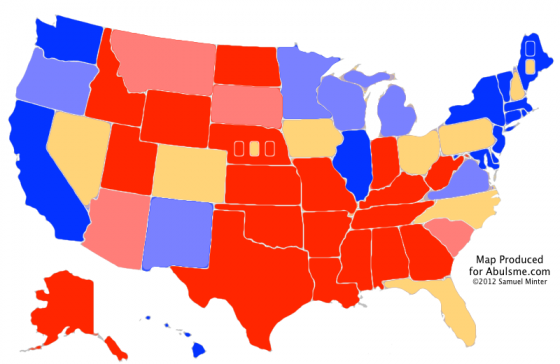
|
Romney |
Obama |
| Romney Best Case |
299 |
239 |
| Current Status |
206 |
332 |
| Obama Best Case |
190 |
348 |
Romney’s best case is one electoral vote better than yesterday since I consider the possibility of him winning ME-2.
Basically though we’re exactly the same place that we have been. Obama ahead, but Romney can win if he steals a bunch of the states where Obama is ahead, but only by a small margin.
Looking at the tipping point margin again:
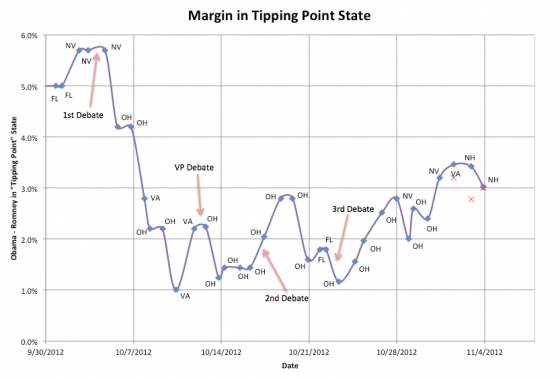
The outlier in Virginia I mentioned yesterday and the day before still hasn’t rolled off, but the other states have moved in such a way that it barely makes a difference now. At the moment the tipping point state is New Hampshire, where the margin is a 3.02% Obama lead. If you “fixed” the outlier in Virginia, the tipping point state would be Ohio, where Obama’s lead is now 3.0%. Pretty much the same.
So we remain where we have been. Unless the polls are all wrong and biased toward Obama, Romney has to make up about 3% in the key states in order to pull ahead and win this.
Three days left until the first polls close and we start getting actual election results.
Will anything change in the last three days? Probably not. But I suppose there is always that chance.
Note: Chart and map from the Abulsme.com 2012 Electoral College Prediction page. Both assume Obama vs Romney with no strong third party candidate and show polling as it currently exists. Things will change before election day. On the map red is Romney, blue is Obama, gold states are too close to call. Lines on the chart represent how many more electoral votes a candidate would have than is needed to tie under several different scenarios. Up is good for Obama, Down is good for Romney.
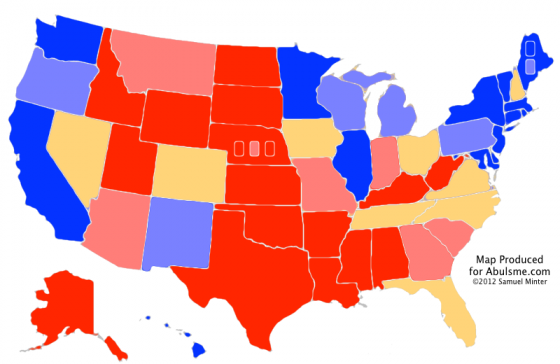 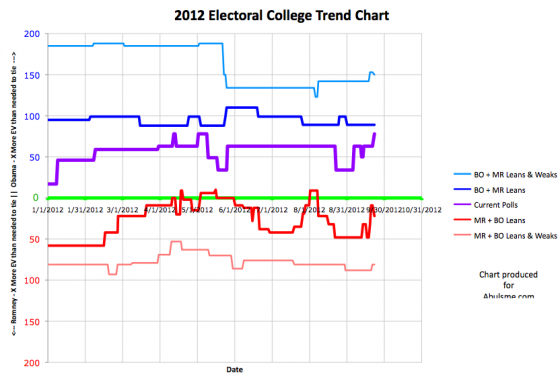
Big day, lots of changes in polls behind the scenes aided by the fact I’ve now added PollTracker as a source. They seem to be picking up and including some polls left out by my other sources. The big batch of new polls today led to three category changes. So lets get to them in order of electoral college size from small to large:
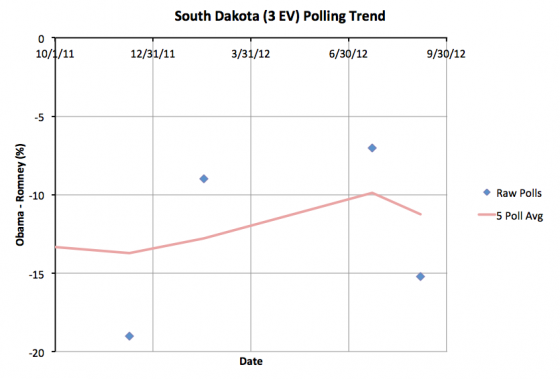
First up, South Dakota with 3 electoral votes. It has been very sparsely polled, but it is easy to see why. This state is not even remotely in contention. It is a Romney state. Back in August a new poll had brought the five poll average down to a Romney lead of less than 10%, moving it to “Weak Romney” instead of “Strong Romney”. Now the first poll since then moves it back to “Strong Romney”. Either way, South Dakota is not a state we imagine Obama winning even in his best possible scenario.
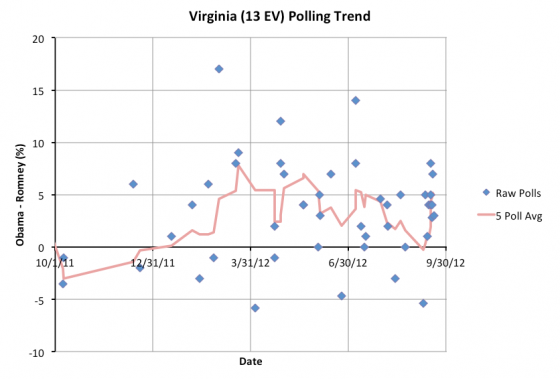
Next up is Virginia with 13 electoral votes. On Thursday Obama’s lead in the state tipped just barely over 5%. With a new poll today, it dips back just barely below 5%. So once again it goes into my “Lean Obama” category and it is once again considered one of the states Romney *could* win, even though he is currently behind in the state. So this improves Romney’s best case and opens up more possible “paths to victory” that one can mathematically imagine given the polling.
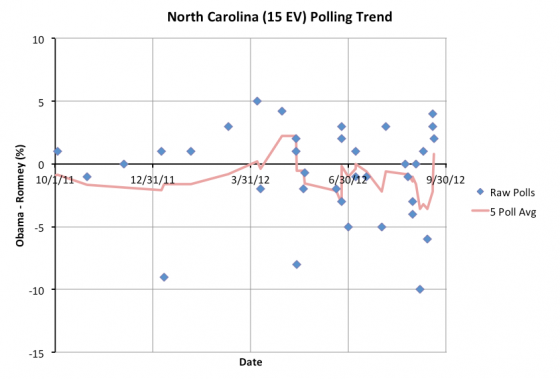
Finally, North Carolina with 15 electoral votes. Never once in the last year has this state not been “close”. Most of the time it has leaned toward Romney though, with just a few bounces toward Obama. Today’s batch of new polls are all favorable to Obama though, and the five poll average tips toward Obama, barely, at a 0.8% lead for Obama.
Now, there is some oddness in how I count polls here. When a poll includes results in more than one way (Likely Votes vs Registered, or with our without Leaners) rather than picking one version of the poll based on some criteria I make up, I count those as separate polls if they are reported differently by the sources I use. This will potentially overweight the one poll with multiple reports. I count on this effect being washed out over time. This state is close enough that it can make a difference though.
But the difference is between just barely leaning one way, and just barely leaning the other way. These two situations are barely distinguishable from each other. So, for instance, in the case of North Carolina, while the new polls tip the state over the center line, it should be kept front of mind that a 0.8% lead is NOTHING and is close enough that it can easily just be statistical or methodological noise, and even if it isn’t, is close enough it can be wiped out overnight by the events in a news cycle.
So while this does move the “everybody gets every state they are ahead in” line in my models, do keep in mind that ALL of the “close” states should be considered to be states that easily could go either way.
So, with all of these, the new model summary:
|
Romney |
Obama |
| Romney Best Case |
291 |
247 |
| Current Status |
191 |
347 |
| Obama Best Case |
180 |
358 |
With this the “Current Status” where everybody gets every state they are ahead in is back up to matching Obama’s previous highs in April and May. Even with Obama’s best case, he isn’t matching his 2008 performance. But he is at what has so far been his ceiling in this race. To move beyond this he needs to start pulling ahead in states like Tennessee, Georgia, Arizona, Indiana, Missouri, South Carolina and Montana. All of these have so far seemed way out of reach this time around. And they still do. We would need a major Romney collapse to start bringing these states over to Obama.
As I said though, this lead in North Carolina is by the slimmest of margins, and is helped along slightly by my methodology. It would not be surprising at all for this to flip back to the “normal” 332 to 206 Obama victory margin we’ve been seeing most of the year in my model.
In the mean time, Virginia getting a bit closer again is good news for Romney. If he can’t bring states like Virginia back to being at least close, it is really hard to see how he pulls off a win. Having said that though, the recent trend in Virginia has been against him. We’ll need more polls (I’m sure we’ll have them soon) to know if Romney is really making Virginia close again, or if it will slip back away from him with the next batch of polls.
Note: Chart and map from the Abulsme.com 2012 Electoral College Prediction page. Both assume Obama vs Romney with no strong third party candidate and show polling as it currently exists. Things will change before election day. On the map red is Romney, blue is Obama, gold states are too close to call. Lines on the chart represent how many more electoral votes a candidate would have than is needed to tie under several different scenarios. Up is good for Obama, Down is good for Romney.
(Edited 2012 Sep 22 23:50 to add some final thoughts and do some cleanup.)
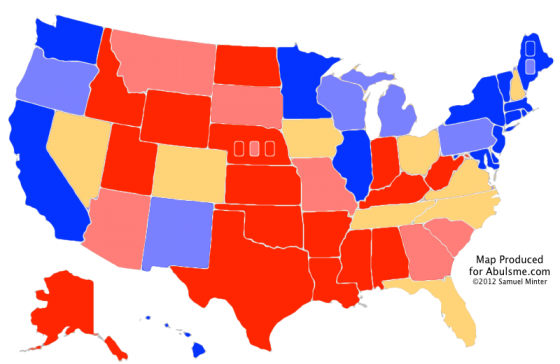
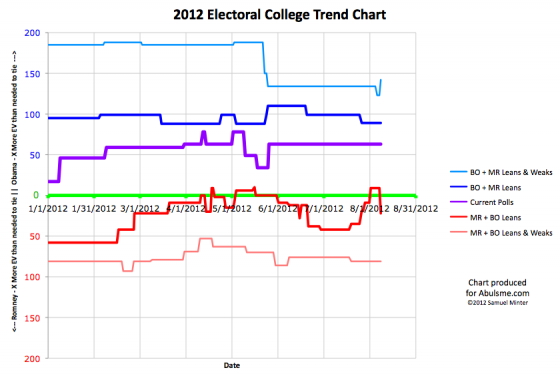
Chart and map from the Abulsme.com 2012 Electoral College Prediction page. Both assume Obama vs Romney with no strong third party candidate and show polling as it currently exists. Things will change before election day. On the map red is Romney, blue is Obama, gold states are too close to call. Lines on the chart represent how many more electoral votes a candidate would have than is needed to tie under several different scenarios. Up is good for Obama, Down is good for Romney.
Four states change categories today. In all four cases, the races look a little closer than they did. The impact is different in these cases, so lets look at each one. In order from the smallest number of electoral votes to the greatest…
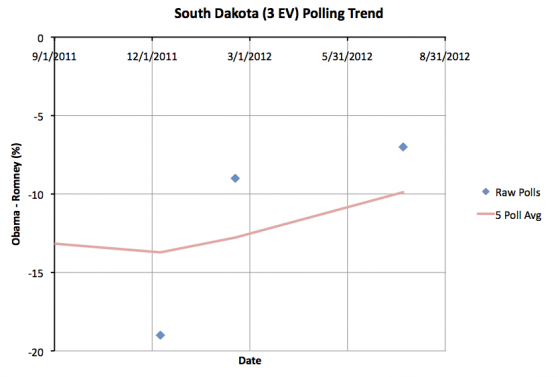
South Dakota (3 ev): South Dakota has been very sparsely polled. The poll added today is only the 3rd one in the last year and only the 4th since the 2008 election. With this update the 5 poll average (which includes the 2008 election to fill out the average) drops to a Romney lead of 9.9%. This is less than the 10% threshold I use, so I move the state from “Strong Romney” to “Weak Romney”. But obviously South Dakota is nowhere close to being a competitive state. It would take a move of epic proportions to actually make South Dakota a competitive state. But the three polls this year do seem to show that Romney’s lead is a bit less than it once was.
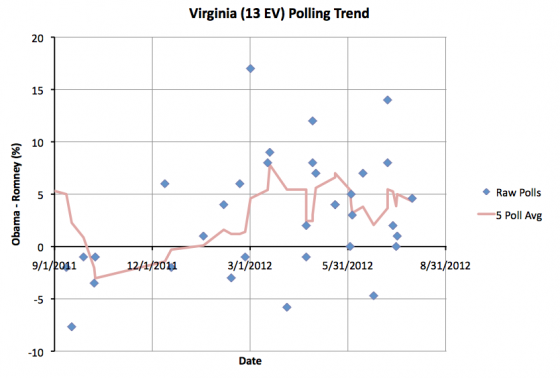
Virginia (13 ev): Obama’s lead in the five poll average had touched 5%, moving it out of the close state category, but it didn’t last. The latest poll added to the average brings Obama’s lead back down to 4.3%. This means Virginia is once again one of the states I consider close enough that it could easily go either way depending on the events of the campaign. This will improve Romney’s “Best Case” in my models. Virginia has been close for most of the last year so it is not surprising to see it here again.
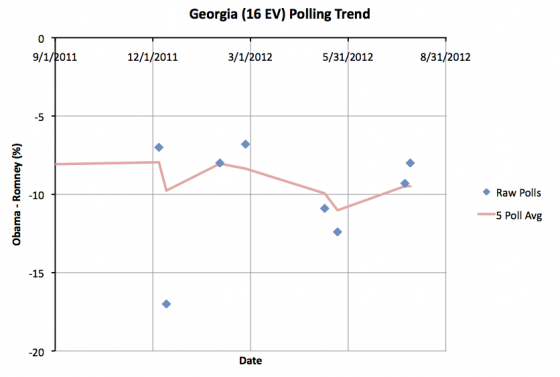
Georgia (16 ev): With two new polls added today, Romney’s lead in Georgia drops to 9.5%. Since this is below 10%, we move the state to “Weak Romney”. As with South Dakota, this is still a pretty substantial lead, and absent a major Romney collapse, it is unlikely to see Georgia actually become a competitive close state. But it is once again in the category where perhaps Romney shouldn’t take it completely for granted. Well, OK, he mostly can. But his margins do look a little bit less than they did before.
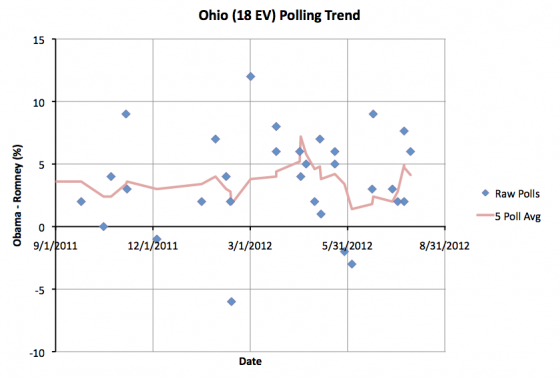
Ohio (18 ev): Along with Virginia, this is the other one that “matters” to the model. In my August 1st update the 5 poll average in Ohio jumped to 5.5%, moving it out of my swing state category. In today’s update we add a new poll… actually one that ended back on July 24th, prior to the last poll included in my last update, but which I just found (via Darryl at HorsesAss) so it counts for today*… and that new poll pulls Obama’s lead back down to 4.1%. So after the brief interlude as a blue state, Ohio is once again where it has been most of the year… with an Obama advantage, but not a huge one. So it is easy to imagine scenarios where Romney pulls it back over onto his side of the fence.
When you add up the changes in these four states, what do you get?
Well, South Dakota and Georgia really don’t change anything. For those two states, it isn’t about who will win, it is just about how much Romney will win by… which really doesn’t matter.
Virginia and Ohio on the other hand… they matter, and they are pretty big states. With both of these states on the table again, Romney’s best case improves considerably:
|
Romney |
Obama |
| Romney Best Case |
291 |
247 |
| Current Status |
206 |
332 |
| Obama Best Case |
180 |
358 |
With this new configuration, Florida (29 ev) is a must win state. Romney can’t win without it. He could lose any one of Ohio (18 ev), North Carolina (15 ev), Virginia (13 ev) or Tennessee (11 ev), but only one of them. Colorado (9 ev), Iowa (6 ev), Nevada (6 ev) and New Hampshire are more flexible. There are a number of different “paths to victory” here now.
Now, most of these states (all but North Carolina and Tennessee) are ones where Obama has the lead at the moment, even if it is a small lead. To actually win, Romney has to actually start pulling ahead in some of these states rather than just reducing Obama’s lead.
That may be next. With a VP announcement “any time now” and the Republican Convention just around the corner, movement toward Romney should probably be expected. The questions will be: “How much movement?” and “Does it last?”.
(Spoilers: Convention bounces usually last about a week before things revert to where they were before, and VP choices only rarely end up making a difference.)
* If there is anybody who cares about the details and wonders why I didn’t do a retroactive adjustment of the historical graphs because I included an older poll that changed things, here is a long geeky explanation of my process: Basically, if you judge by the “end date” of the polls, polls come in out of order all the time. It takes pollsters a few days to compile and release their data, then sometimes it take a bit before it shows up on one of the three sources I use to collect poll data. If a new poll is within the “Last 5”, then I just treat it as current new data, regardless of the end date on the poll and if it is really the most recent to end. In this case, the poll wasn’t the newest, but it was the second newest. The last two polls had just gotten to me in reverse order, which happens pretty frequently. It is a little unusual that by the time I included it, the poll end date was about two weeks old, but it was still the second most recent poll. So it just got folded into the average normally. If I become aware of polls that are older than the Last 5, and those polls would have changed the category of any states, then I’ll fold a correction into my next update. Also while I’m giving esoteric details… The historical electoral college trend lines are based on the date new polls are included in my model (except when polls older than the most recent 5 are added), while the state polling trend chart uses the end date of the polls, which means they don’t always match exactly. So, for instance, the peak over 5% in Ohio has indeed disappeared with this new poll, instead now only peaking at 4.9%. The end dates of the polls are also used to determine just which polls are in the “Last 5” to begin with. In the case of multiple polls with the same end date, the tie breaker is the time they were added to my model.
Edit: 2012 Aug 8 08:15 to add that last parenthetical.
Edit: 2012 Aug 8 16:31 to add * note.
Edit: 2012 Aug 8 17:50 to correct one detail on the * note.
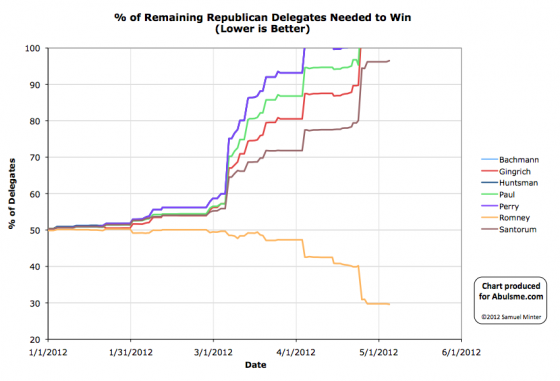
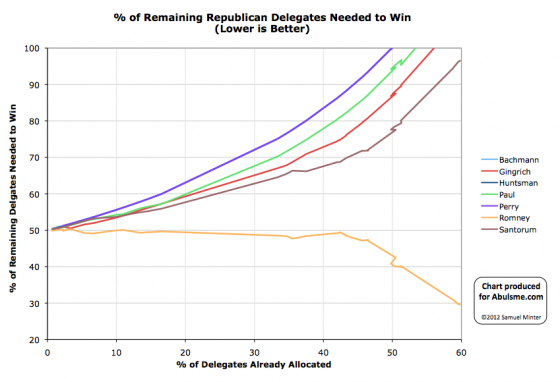
Charts from the Abulsme.com 2012 Republican Delegate Count Graphs page. When a candidate gets down to 0%, they have clinched the nomination. If they get above 100%, they have been mathematically eliminated. The first chart is by date, the second is by “% of Delegates Already Allocated”. These numbers include estimates of the eventual results of multi-stage caucus processes which will be refined as the later stages occur.
If you remember, in Ohio Santorum did not file all the right paperwork to have actual human delegates designated to fill the slots he might win in some parts of the state. There were four delegate positions that Santorum won, but wasn’t going to be able to claim because of that. Well, it looks like the Romney folks decided to be nice and not challenge Santorum’s ability to retroactively fill those four delegate slots. So Santorum will get those four delegates after all. So Santorum +4 in Ohio.
Meanwhile, DCW adjusts their Superdelegate Count. One Alabama super switches from Santorum to Romney. And then Romney gains two more previously undeclared supers, one from Alabama and one from South Dakota.
Net for the day, Romney +3, Santorum +3. At 50%, this is of course well over the 29.7% of the delegates Romney needs to be tracking to in order to clinch the nomination.
In terms of “% of remaining needed to win”:
- Romney: 29.7% -> 29.6%
- Santorum: 96.2% -> 96.5%
Next real contests on Tuesday.
|
|

































